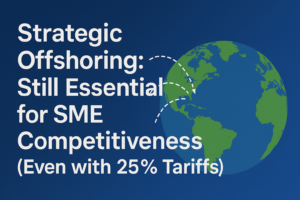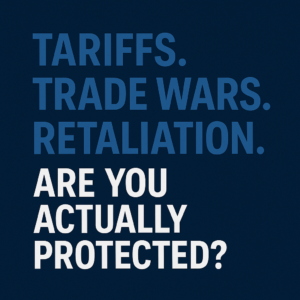
SME manufacturers in tech and hardgoods face a strategic choice: make key parts in-house/locally or source them offshore. Recent tariff hikes and reshoring talk might tempt some to pull everything local. But the data tells a different story – strategic, selective offshoring of metal, plastic/composite, and electrical parts and subassemblies remains crucial for cost competitiveness, even after accounting for 25% import tariffs.
Offshore vs. Local: A Cost Analysis
Consider two scenarios (for a component used in your product) that compare offshore sourcing to local in-house production. The cost breakdowns below assume a 25% tariff on imports and ~5% shipping cost, contrasting an offshore supplier vs. local manufacturing:
Table 1 – Cost Comparison (Selling price = $131):
| Cost Element | Offshore Source | Local Source/In‑house |
|---|---|---|
| Direct Material | $10.00 | $13.00 |
| Direct Labor (1 hr) | $15.00 | $65.00 |
| Cost of Goods Sold (COGS) | $25.00 | $78.00 |
| Tariffs (25%) | $31.25 | N/A |
| Landed Cost (+5% shipping) | $32.81 | $78.00 |
| Selling Price | $131.00 | $131.00 |
| Margin | 75% | 40% |
Table 2 – Cost Comparison (Selling price = $55):
| Cost Element | Offshore Source | Local Source/In‑house |
|---|---|---|
| Direct Material | $10.00 | $13.00 |
| Direct Labor (1 hr) | $15.00 | $65.00 |
| Cost of Goods Sold (COGS) | $25.00 | $78.00 |
| Tariffs (25%) | $31.25 | N/A |
| Landed Cost (+5% shipping) | $32.81 | $78.00 |
| Selling Price | $55.00 | $55.00 |
| Margin | 40% | -42% |
Key takeaways from the above:
-
Dramatically lower cost of goods offshore. Even after a 25% tariff and shipping, the landed cost of the part offshore is less than half the local cost in these examples (e.g. $32.81 vs $78.00 in Table 1). High Western labor rates (here $65/hr vs. $15/hr offshore) drive local COGS up.
-
Stronger profit margins. The offshore-sourced part retains healthy margins (40% – 75%) at typical selling prices, whereas the local alternative’s margin shrinks to 40% or even turns negative (–42%). Simply put, certain products would be unprofitable if fully made locally, even with tariffs factored in.
-
Global pricing competitiveness. Lower component costs mean finished products can be priced competitively in global markets. A 75% margin on a $131 item provides room to invest in R&D, quality, and price flexibility that a 40% margin (or a loss) simply cannot support.
The conclusion is clear: local sourcing for these inputs is often not commercially viable, whereas offshoring preserves margins and global competitiveness. As one trade analysis bluntly states, “Through trade, producers can access lower-cost inputs used in production … which can improve global competitiveness.” The 25% tariff acts as a speed bump – but not a roadblock – to cost savings. Even after tariffs, offshore parts remain cost-advantaged, keeping your bill of materials lean and competitive.
Global Supply Chains = Competitive Advantage for SMEs
It’s not just about one part or one tariff. Embracing global supply chains strategically can boost your company’s overall performance. The OECD finds that “SMEs engaged in global value chains (GVCs) tend to be more productive, have higher revenue, and obtain access to more diversified products and services.” In other words, plugging into international supplier networks can supercharge an SME’s growth by leveraging the best capabilities worldwide.
Yes, we all acknowledge recent supply chain disruptions and the push for resilience. But “even local or regional production doesn’t necessarily offer lower risks than offshore production” and often carries much higher costs. Many manufacturers who tried to “reshore” or shift to nearer suppliers “found their cost structures significantly higher”. Meanwhile, overseas hubs have kept their edge – “across a broad range of industries, China emerges as the most cost competitive nation”, according to IndustryWeek. The reality is that global supply chains remain indispensable for cost efficiency.
Instead of an all-or-nothing approach, forward-looking SMEs are strategically offshoring select parts (especially labor-intensive metal/plastic components and electronic subassemblies) while focusing domestic resources on core design, assembly, and innovation. This balanced strategy lets you capture cost savings abroad without sacrificing control over your product’s key IP and quality. It’s a best-of-both-worlds approach: maintain agility and quality at home, leverage scale and cost advantages abroad.
“Through trade, producers can access lower-cost inputs… which can improve global competitiveness.”
“SMEs engaged in global value chains… tend to be more productive, have higher revenue…”
“Many [firms] relocated operations or switched to domestic or near-shore suppliers but found their cost structures significantly higher” – and “across a broad range of industries, China emerges as the most cost competitive nation.”
The message for SME CEOs, COOs, and Operations leaders is unequivocal: Don’t throw away your global supply chain advantages. Use them strategically. Optimize what you produce in-house (your differentiators) versus what you source from expert low-cost suppliers. This will preserve your margins, price competitiveness, and ability to reinvest in innovation. Globalized sourcing isn’t just a big-company game; it’s a lifeline for medium-sized manufacturers to punch above their weight in international markets.
Stay Competitive – Let’s Talk Strategy
Is your company leveraging smart offshoring to its full potential? In an era of 25% tariffs and changing trade winds, making the right sourcing moves is more critical than ever. I invite you to continue this conversation – let’s explore how a strategic global supply chain approach can safeguard and boost your margins. Book a 20-minute briefing with me to discuss your current sourcing strategy and find out how to refine it for maximum competitiveness: https://app.apollo.io/#/meet/david_orton_b36.
Let’s ensure your manufacturing business thrives globally by combining the best of local innovation with the cost advantages of global supply. Competitive advantage awaits – let’s seize it together.
#StrategicSourcing #Offshoring #GlobalSupplyChain #SMEManufacturing #ManufacturingStrategy #CostReduction #SupplyChainOptimization #Tariffs #Nearshoring #ReshoringDebate #IndustrialManufacturing #SmartManufacturing #OperationsLeadership #GlobalCompetitiveness #TechManufacturing #Hardgoods #MetalFabrication #PlasticComponents #ElectricalAssemblies #ManufacturingExcellence #B2BManufacturing #COOInsights #VPofOperations #SupplyChainResilience #MarginsMatter





